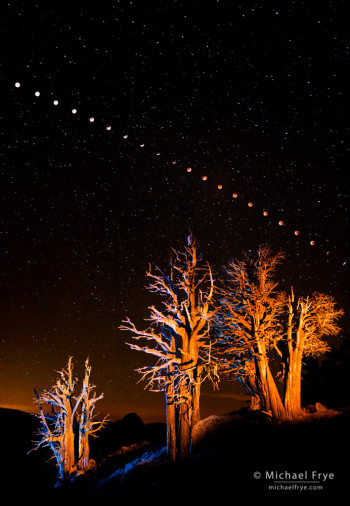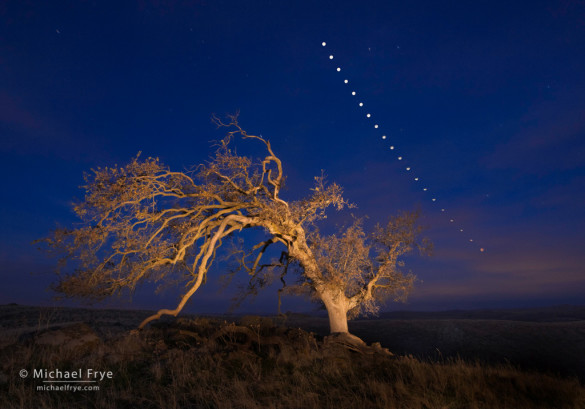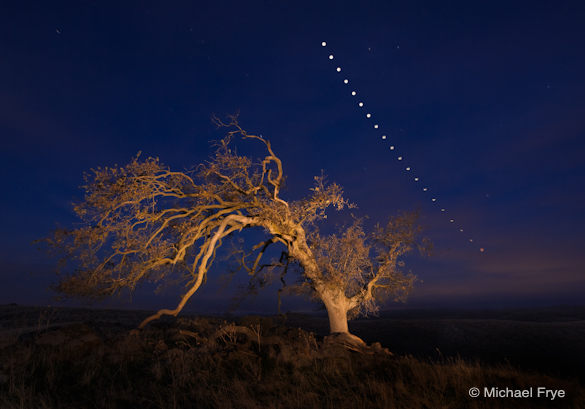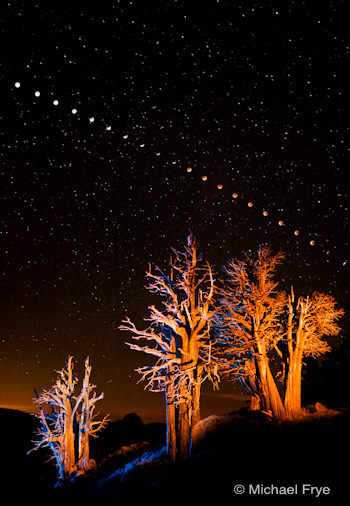by Michael Frye | Apr 7, 2014 | Photography Tips

Lunar Eclipse Sequence, 1:23 a.m. to 4:49 a.m., August 28, 2007, Yosemite NP, CA
On the night of April 14th and 15th viewers in North and South America will be able to see a total lunar eclipse. Most people should be able to see the whole eclipse sequence (weather permitting), though viewers in the far northeast will miss the very end of the event.
I’ve photographed several lunar eclipses, and they’re spectacular events to view and photograph. This one is special, however, because it’s the first time I might be able to see the whole eclipse sequence from beginning to end. In California the eclipse will be seen almost due south. This is not a great alignment for Yosemite Valley, though it should be possible to see the eclipse over Cathedral Rocks or Sentinel Rock. But California is a diverse state with many other possible locations, so I’ll be thinking about other possible locations between now and the 14th.
If you’re interested in photographing the eclipse, I’ve written a guest post about it for the Borrowlenses.com blog. Although I’ve posted other articles about eclipses before, this new article is the most complete and comprehensive, with details about focusing in the dark, revised exposure times, how to align the eclipse with a foreground object (like a building, mountain, or tree), and more.
This is one night when I hope the clouds will stay away. 🙂
— Michael Frye
(more…)
by Michael Frye | Dec 30, 2013 | Announcements

Oak tree and lunar eclipse sequence, Mariposa County, Sierra foothills, CA, USA
One of my most popular posts this year was a recent one, called Moonstruck. This article focused on how to capture moonrise and moonset photographs, with a discussion about how to predict the moon’s movements, and apps that can help with figuring out the precise position of the sun and moon.
While the Moonstruck article focused on photographing moonrises and moonsets, I’ve also written about photographing by moonlight. Tips for Photographing Lunar Rainbows delves into the specifics of moonlight photography: camera settings, shutter speeds, and how to focus in the dark. And in another post from 2012 I described the experience of photographing lunar rainbows in Yosemite, first with the crowds of photographers in Cook’s Meadow, then along the Upper Yosemite Falls Trail. And then late last year I wrote about my most memorable New Year’s Eve, and how that inspired me to make a photograph of the Three Brothers by moonlight.
(more…)
by Michael Frye | Dec 14, 2011 | Advanced Techniques

Oak tree and lunar eclipse sequence, December 10th, 2011
For me the hardest part about photographing last Saturday morning’s lunar eclipse was finding a good location. The fully-eclipsed moon would be close to the horizon in the west-northwest, so I needed a clear view in that direction, ideally with an interesting object in the foreground.
No place in Yosemite seemed to fit—too many mountains in the way. But I thought a remote region of western Mariposa County, with rolling hills and scattered oaks, might work. A week before the eclipse I scouted this area and found a photogenic oak tree on top of hill that seemed to line up with the projected path of the eclipse.
Friday night my student Erik and I got a couple hours of sleep, drove out to this spot, hiked up the hill, set up our cameras, and started our interval timers to capture a sequence of moon images ten minutes apart. We had a long wait, but it wasn’t too cold, and we enjoyed our peaceful, moonlit surroundings. A pair of great-horned owls serenaded us, and groups of coyotes howled at regular intervals. At one point Erik watched four coyotes climb a nearby moonlit hill, then saw one of them stop and howl.
(more…)
by Michael Frye | Dec 5, 2011 | Advanced Techniques, Photography Tips

Lunar Eclipse Sequence, 1:23 a.m. to 4:49 a.m., August 28, 2007
Before getting to the topic at hand, I want to let you know that eight people have signed up for the Eastern Sierra Fall Color Workshop since I announced it last Thursday. The limit is twelve students, and I’m sure it will fill up soon, so if you’re thinking about signing up don’t procrastinate!
Okay, on to the eclipse. Before dawn this Saturday, December 10th, viewers in the Western U.S. and Canada will be able to see a total lunar eclipse. If you live in the eastern half of the U.S. unfortunately you’ll only be able to see a partial eclipse. People in most of Europe, Asia, and Australia will also be able to see a total eclipse, though in Europe it will be visible at moonrise on Saturday evening. This NASA page shows where the eclipse will be visible throughout the world, and this page shows more detail for western North America.
Moon Position
If the weather cooperates, and you want to try make your own eclipse photographs, here are some tips. (I’ve copied some of this from my post a year ago, but the information about the moon position is all new.)
(more…)












